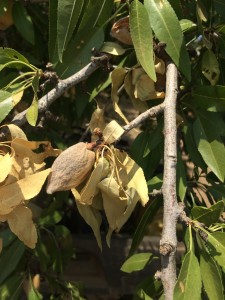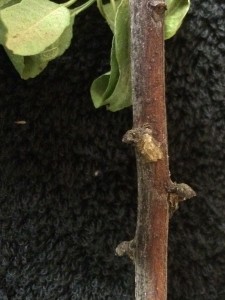
There have been a lot of reports of poor removal of ‘Nonpareil’ almonds. This issue may be caused by a few different issues, all which require a different management plan. The potential causes as well as some thoughts on management are provided below:
1. Uneven ripening. Uneven ripening can be caused by several different things. A long, protracted bloom can create a delay in ripening due to the length of time between the first and last fruit that was pollinated and fertilized. Also, vigorous growing conditions can delay the ripening process. These include more than adequate water and nitrogen through the entire growing season. Often, this is observed in younger orchards as they are being “pushed” along with increased water and nutrients. Not much can be done about the long bloom period, but properly timed irrigation and nitrogen applications in the spring (especially early spring) can help reduce excessive vigor.
2. Hull rot. Once a hull is infected by Rhizopus or Monilinia, a toxin is secreted which leads to the death of fruit wood. As this toxin kills tissues, it can cause them to gum – especially at the peduncle, effectively gluing the nuts to the spur. These nuts are very difficult to remove and hull rot management practices should be utilized to help reduce the occurrence of this disease. In years were humidity is high at the onset of hull split, cultural management practices appear to be less effective.

3. Boron Toxicity. Becoming a bit more common with the expansion of trees onto lower quality land or irrigation from low quality water. Boron toxicity is identified as die back of this year’s shoots, gummy deposits that form at wounds or other plant openings (bud scars, lenticels, etc.), and corky areas on the midrib on the lower side ofleaves. The gum that is exuded out of bud scars may cause nuts to stock to the trees, similar to hull rot above. Gum may be a light brown to clear in color. To determine boron toxicity, a hull analysis must be sampled. Soils and water with boron levels over 0.5 mg/l are at risk, with increasing risk as boron levels increase. Water sources with higher than desired levels of boron should be used with caution as boron accumulation in the soil can quickly lead to toxicity.
4. Lack of irrigation. Hull/stick-tights can form when a severe deficit irrigation is applied in between hull split and harvest. If possible, try and reduce severe tree stress as this will increase the occurrence of stick-tights. If utilizing regulated deficit irrigation, tree stress levels should be kept less than -15 bars, if possible.
There also may be other reasons for nuts sticking to the spurs. If any of the above situations do not appear to describe your situation, please feel free to let us know!

